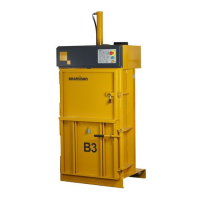What to do if BRAMIDAN Trash Compactor is unable to eject the bale?
- SSamantha AlexanderJul 28, 2025
If your BRAMIDAN Trash Compactor is unable to eject the bale, several issues could be the cause. First, ensure that the two-hand control is responding correctly, as it requires simultaneous constant pressure within a time interval of ½ second. Check that the emergency stop has not been activated and that the top switch is free of obstructions. Also, inspect the ejection system for any foreign objects. If the strap or steel wire is incorrectly installed, cut it and tip the bale out of the chamber, then press the bale again.

